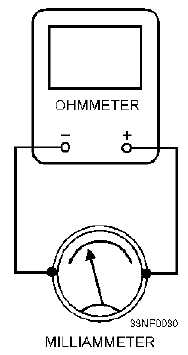2-24
Figure 2-19.—Measuring current passed by an ohmmeter.
Resistance measurements usually are not made in transistorized circuits, except when you are
checking for open windings in transformers and coils. When a resistance check is required, the transistors
are usually removed from the circuit. Resistance checks cannot test all the characteristics of transistors,
especially transistors designed for high frequencies or fast switching. The ohmmeter is capable of making
simple transistor tests, such as open and short tests.
Refer to NEETS, Module 7, Introduction to Solid-State Devices and Power Supplies, for a review of
transistor and semiconductor terms and theory.
SUMMARY
The important points of this chapter are summarized in the following paragraphs:
The BEL is a unit that expresses the logarithmic ratio between the input and output of any given
component, circuit, or system and can be expressed in terms of voltage, current, or power.
Any figure expressed in bels can be converted to DECIBELS by multiplying the figure by 10. The
decibel cannot be used to represent actual power, only a ratio of one power to another.
The abbreviation dBm is used to represent power levels above or below a 1 milliwatt reference level.
A BOLOMETER is a device that undergoes changes in resistance as changes in dissipated power
occur. The two types of bolometers most often used are the barretter and the thermistor.
FREQUENCY MEASUREMENTS can be divided into two broad categories: mechanical-rotation
frequency and electrical-output frequency measurements.

